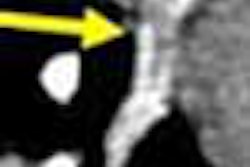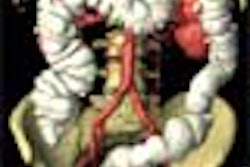Facial trauma imaging is now dominated by CT rather than radiography, say radiologists who uncovered a decade-long trend at Massachusetts General Hospital in Boston. But thanks to CT's evolving speed and workflow improvements, the transition has not increased the number of exams or their overall cost.
"Each year in the United States, an estimated 175,000 individuals sustain severe facial injury.... Thousands more suffer moderate and minor facial injuries," noted Dr. Brian Turner, Dr. James Rhea, Dr. James Thrall, and colleagues in the September American Journal of Roentgenology. "In fact, 45,550 facial injuries classified as moderate or severe occurred as a direct result of motor vehicle collisions. A substantial number of the remaining injuries are due to falls, sports-related injuries, and, less often, penetrating trauma such as gunshot or knife wounds" (AJR, September 2004, Vol. 183:3, pp. 751-754).
MDCT has revolutionized facial imaging with its ability to provide a complete evaluation in a 35-second axial scan, from which high-quality reformatted coronal, sagittal, curved-plane, oblique, and 3D images can be produced, without further scanning, to depict bone and soft-tissue injury, the authors wrote.
The study sought to determine whether increasing CT use for facial imaging was raising the cost or volume of imaging exams at the large level 1 trauma center. The researchers retrospectively reviewed the imaging methods for all patients assessed for suspected facial trauma in 1992 and 2002, including follow-up images within seven days of the original exam.
Throughout the decade-long study period, the standard radiographic nasal series included Waters, lateral nasal, and occlusal views. The mandibular series consisted of the Towne, true lateral, left oblique, right oblique, and base views. The orbital series included the Waters, lateral, bilateral, optic foramen, and Caldwell views; and the facial series consisted of the Waters, Caldwell, Towne, left lateral, right lateral, and base views, they wrote.
However, CT scanning faced significant changes over the same decade. In 1992, for example, the facility used a single-slice helical scanner (9800, GE Healthcare, Waukesha, WI). The protocol required separate axial and coronal acquisitions (3-mm slice thickness, 3-mm intervals) with hyperextension of the neck -- effectively ruling out CT for patients with neck injuries, the authors wrote. All results were interpreted using hard copies.
By 2002 the group had acquired a four-slice scanner (LightSpeed, GE Healthcare), conducting facial exams in a single axial acquisition from the sinuses to below the mandible (4 x 1.25 mm, HQ mode, 1.25-mm reconstruction interval, pitch 3). Reconstructions were performed on a separate Vitrea workstation (Vital Images, Plymouth, MN). In 2002, both x-ray and CT images were interpreted electronically on a PACS workstation.
Of 890 patients examined for suspected facial injury in 1992, 671 (75.4%) had only radiography, 153 (17.2%) had only CT of the face, and 66 (7.4%) had both exams, the authors reported. Between 1992 and 2002, total admissions to the level 1 trauma center grew from 67,004 to 75,770.
By 2002 the modalities had essentially changed places. Of 828 patients examined for suspected facial injury that year, 584 (70.5%) had only CT of the face, 228 (27.5%) had only radiography, and 16 (1.9%) had both exams, for a total of 600 patients undergoing a CT exam.
Among these 600 patients, 663 facial fractures were diagnosed in 340 patients (56.7%). In 2002 the most frequently seen fractures in CT were nasal and nasoorbital ethmoid fractures (n = 175, 26.4%), maxillary and Le Fort fractures (n = 169, 25.5%), orbital fractures (n = 168, 25.3%), and zygoma fractures (n = 74, 11.2%).
Of those patients diagnosed with fractures on CT (n = 271, 79.7%), other injuries were common, including traumatic brain injury (n = 58, 17.1%). Cervical spine CT was conducted in 199 patients (58.5%), of which 12 exams (6.0%) were diagnosed with injury, the authors wrote. Among 116 (34.1%) patients who underwent abdominal CT, injuries were observed in 21 (18.1%). Eighty-three patients (24.4%) underwent chest CT, 37 of whom (44.6%) had sustained intrathoracic injuries.
Declining costs and reduced exam time
The number of imaging exams per patient declined from 1.23 in 1992 to 1.03 in 2002. Had the x-ray-dominant 1992 practice patterns continued in 2002, the hospital's actual costs (unrelated to billing charges) for all facial radiography series would have totaled $143,030, or an average of $161 per patient, for all imaging exams, the authors wrote. But in CT-dominated 2002, the actual total was $103,467, or an average of $125 per patient, for all imaging exams.
The authors explained that because viewing methods for both CT and radiography changed with the addition of a PACS network, the researchers did not analyze the hospital's actual 1992 costs for the present study, but rather projected 2002 costs using 1992 examination patterns.
In 1992 it took 40 minutes to acquire both the axial and coronal CT scans, while axial scans in 2002 were acquired in 25 seconds; coronal reformatted images were produced with no additional scan time. The average patient time "on and off the table" remained unchanged at 18 minutes for both years in CT, the group noted. The average radiographic skull series, facial series, or cervical spine series took 28 minutes.
The CT exam is also more comfortable, and avoids the risk of repositioning trauma patients, they wrote.
"With respect to the use of hospital resources and costs, our results show a significant overall cost savings because CT has become less expensive than radiography, and the use of CT has increased relative to radiography," the authors concluded. "In 2002 alone $29,601 was saved using CT as the predominant imaging method.... CT was much more expensive 10 years ago because of longer scanning times and lower throughput."
And because much more anatomic territory can be covered in a single exam, the switch to CT has reduced the number of exams per patient. CT's high positivity rate suggests that the modality is not being overused, they added.
"The increased use of CT and decreased use of radiography over the decade have had a favorable impact on hospital costs because CT of the face has become less expensive than radiography of the face," the authors wrote.
By Eric Barnes
AuntMinnie.com staff writer
September 22, 2004
Related Reading
Tongue and shriek: Piercing makes for unique imaging challenges, July 19, 2004
Nailed in the head: X-ray, CT show patient's good luck, July 13, 2004
Book review: CT of the Head and Spine, September 5, 2002
Low-dose CT touted for oft-needed sinus imaging, February 3, 2002
Copyright © 2004 AuntMinnie.com



















